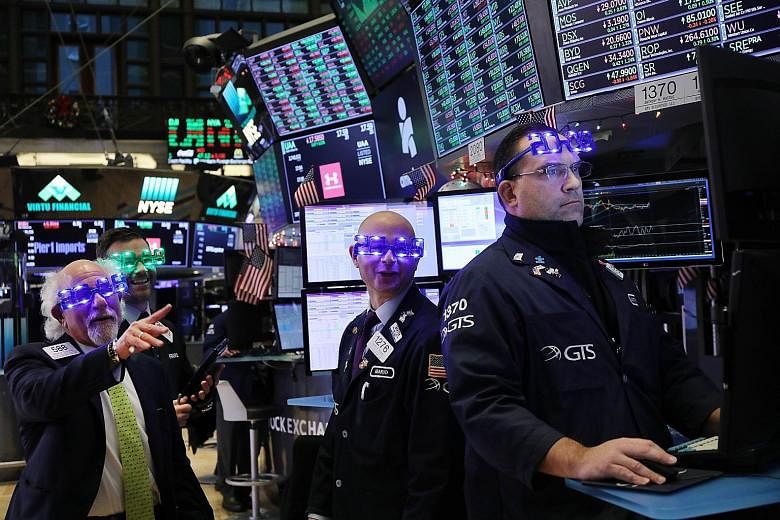NEW YORK • The United States stock market on Monday concluded its worst year since the global financial crisis, following a late-season collapse that also raised doubts about the prospects for this year.
Major indices notched modest gains in the year's final session, but it barely made a dent, compared with the rest of December, the market's worst month in nearly a decade.
Ending in the red for 2018 did not appear on the cards in the first weeks of the year, when Wall Street repeatedly shot to new records on the heels of a sweeping tax cut signed into law in December 2017 by President Donald Trump.
But it did not take long for a host of worries to shake that confidence, from unease over an unpredictable series of trade wars launched by Mr Trump, to angst over rising interest rates, to nervousness over economists' warnings of slowing growth, or worse, a possible recession.
And the declines rapidly accelerated in the final weeks of last year, erasing all the gains since January.
Concluding the year with losses is "astonishing", Manulife senior portfolio manager Nate Thooft told Agence France-Presse. "From an investor perspective, it probably shakes them a bit."
There was a spurt of renewed optimism on Monday, and the Dow Jones Industrial Average finished the final session with a gain of 1.2 per cent at 23,327.46. The broad-based S&P 500 climbed 0.9 per cent to end at 2,506.85, while the tech-rich Nasdaq Composite Index advanced 0.8 per cent to 6,635.28.
But even with Monday's boost, the Dow finished last year with a loss of 5.6 per cent compared with the end of 2017, the S&P 500 with a drop of 6.2 per cent and the Nasdaq with a decline of 3.9 per cent.
That was after a year in which the indices jumped 25.1 per cent, 19.4 per cent and 28.2 per cent - before companies logged massive jumps in profits last year due in part to the tax cut.
At the start of last year, investor sentiment ranged somewhere between optimism and euphoria as the Dow surged above 25,000 for the first time and then hit 26,000 less than two weeks later.
But after that frothy start, stocks experienced their first cracks in late January, just ahead of a leadership transition at the Federal Reserve as Mr Jerome Powell took over as Fed chairman, after Mr Trump declined to nominate Ms Janet Yellen for a second term.
Wall Street suffered an especially profound wobble on Mr Powell's first day, Feb 5, with the Dow plunging nearly 1,600 points at one stage before ending a grim session down more than 4 per cent.
At the time, analysts cited worries that the Fed would have to hike rates too aggressively.
But Mr Trump's escalating trade wars and tariff threats soon took over. He announced the first salvo on March 1: tariffs on imported steel and aluminium.
The following day, on Twitter, he proclaimed that "trade wars are good, and easy to win". That has been followed by increasingly aggressive tariff moves against China.
Many key US economic indicators stayed robust even as business leaders recoiled at Mr Trump's rising protectionism, with unemployment lingering at a 49-year low, corporate earnings notching their strongest growth in eight years, and business and consumer sentiment remaining well above historic trends.
In August, the S&P 500 celebrated the longest-ever "bull market", with 3,453 straight sessions - more than nine years - without a drop of 20 per cent. In October, the Dow surged to an all-time high of 26,828.39. But it has been a rough ride since.
Besides worries over US-China trade talks, much angst is focused on the Federal Reserve, which faces a tricky balancing act of boosting interest rates enough to contain inflation without choking off the economic expansion.
Market watchers are always nervous about Fed tightening cycles, especially as they reach their end, fearing they might overdo it. But Mr Trump has dialled up the jitters with repeated attacks on Mr Powell.
White House officials have denied Mr Trump intends to fire Mr Powell. But market watchers say the possibility has further pressured stocks. A US government shutdown over Mr Trump's desire to fund a wall along the border with Mexico extending into 2019 also dented sentiment.
"To be clear, the challenges we see ahead don't look to us like the makings of another financial crisis," said a recent investor note by JPMorgan Private Bank said.
"Our base case assumes slowing growth in the US economy throughout 2019 and a moderate recession in 2020."
AGENCE FRANCE-PRESSE

